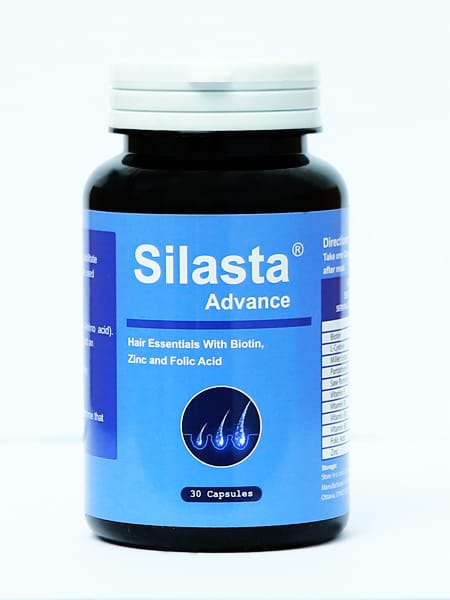Miliacin Associated with Polar Lipids: Effect on Growth Factors Excretion and
Extracellular Matrix of the Dermal Papilla Hair Follicle Model Maintained in
Survival Conditions
BoisnicS1*, BranchetMC1, GaillardE2, and LamourI2
1GREDECO (Group of Research and Evaluation in Dermatology and
Cosmetology), 69ruedela Tour, 75016 Paris, France
2Groupe Robertet, 10 Avenue Yves Emmanuel Baudo in 06130 Grasse, France
*Corresponding author: Boisnic S, Group of Research and Evaluation in Dermatology and Cosmetology (GREDECO), 69 ruedela Tour, Paris, 75016, France, Tel:
33145865882; E-mail:gredeco@orange.fr
Receiveddate: August1,2016; Accepteddate: September15, 2016;
Publisheddate: September22, 2016
Product Research Articals
The Role of Vitamins and Minerals in Hair Loss
Hind M. Almohanna . Azhar A. Ahmed . John P. Tsatalis . AntonellaTosti
Received: October 16, 2018
The Author(s) 2018
ABSTRACT
People commonly inquire about vitamin and mineral supplementation and diet as a means to prevent or manage dermatological diseases and, in particular, hair loss. Answering these queries is frequently challenging, given the enormous and conflicting evidence that exists on this subject.
There are several reasons to suspect a role for micronutrients in non-scarring alopecia. Micronutrients are major elements in the normal hair follicle cycle, playing a role in cellular turnover, a frequent occurrence in the matrix cells in the follicle bulb that are rapidly dividing.
Management of alopecia is an essential aspect of clinical dermatology given the prevalence of hair loss and its significant impact on patients’ quality of life. The role of nutrition and diet in treating hair loss represents a dynamic and growing area of inquiry.
In this review we summarize the role of vitamins and minerals, such as vitamin A, vitamin B, vitamin C, vitamin D, vitamin E, iron, selenium, and zinc, in non-scarring alopecia.
A broad literature search of PubMed and Google Scholar was performed in July 2018 to compile published articles that study the relationship between
Vitamins and minerals, and hair loss. Micronutrients such as vitamins and minerals play an important, but not entirely clear role in normal hair follicle development and immune cell function. Deficiency of such micronutrients may represent a modifiable risk factor associated with the development, prevention, and treatment of alopecia.
Given the role of vitamins and minerals in the hair cycle and immune defense mechanism, large double-blind placebo-controlled trials are required to determine the effect of specific micronutrient supplementation on hair growth in those with both micronutrient deficiency and non-scarring alopecia to establish any association between hair loss and such micronutrient deficiency.
Features for this article go to https://doi.org/10.6084/m9.figshare.7398692.
H. M. Almohanna (&)
Department of Dermatology and Dermatologic Surgery, Prince Sultan Military Medical City, Riyadh, Saudi Arabia
e-mail: mohannahind@gmail.comA. A. Ahmed
Department of Dermatology, King Fahad General Hospital, Medina, Saudi Arabia J. P. Tsahalis A. Tosti
Department of Dermatology and Cutaneous Surgery, University of Miami Miller School of
Medicine, 1475 NW 12th Ave. Suite 2175, Miami, FL 33136, USAA. Tosti
e-mail: ATosti@med.miami.edu
DermatolTher (Heidelb)
https://doi.org/10.1007/s13555-018-0278-6
The Role of B-Vitamins in Hair Growth
People often first look into vitamin and mineral supplementation when we are self-evaluating hair loss or a way in which we can help our hair grow.
As we take a deep dive into the role of B vitamins and what vitamins B for hair growth you will gain a deeper understanding on what the B complex does for you inside and out.
Can Vitamin B Complex Help With Hair Growth?
B vitamins do help in hair growth by encouraging healthy cell rejuvenation through abundant red blood cells which naturally support your hair follicles. This will promote consistent and sometimes faster hair growth.
Because of the emphasis on red blood cells, which not only deliver oxygen throughout our bodies, but also micronutrients that keep our organs running healthy, our scalp can maintain a plentiful foundation to grow and hold our new hair growth.
B-12
Is necessary for yourDNA, proper brain function, and red blood cell formation which is not just essential for survival but also carries value to the development of new hair growth.
B-2 (Riboflavin)
B-2 is made up of two coenzymes that are directly responsible for your body to generate new cells.
B-9 (Folate)
Contains a naturally occurring food folate and folic acids. It is mainly found to live within the liver and is responsible for supporting amino acid metabolism.
As it travels through plasma within our bodies it is important to recognize that a deficiency or sudden intake of folate will directly affect your hair, skin and nails.
Ozuguz et al. J Dermatol Res Ther 2015, 1:2 ISSN: 2469-5750
Journal of Dermatology Research and Therapy Research Article:
Evaluation of Zinc, Vitamin B12, Folic Acid and Iron Levels and Thyroid Functions in
Patients with Chronic Telogen Effluvium
Pinar Ozuguz1*, SevalDogruk Kacar1, Ozlem Ekiz2 and Semsettin Karaca3 1
Faculty of Medicine, Department of Dermatology, AfyonKocatepe University, Turkey
Faculty of Medicine, Department of Dermatology, Mustafa Kemal University, Turkey Department of Dermatology,
Izmir KatipCelebi University, Turkey
*Corresponding author: Pınar Ozuguz, Associate professor, Department of Dermatology, AfyonKocatepe University, Turkey, Tel: 0905055210335, Fax: 0902722463300, E-mail: pozoguz@gmail.com, pozoguz@yahoo.com.tr
Abstract Background and Aim:
Telogen effluvium (TE) is a hair disorder characterized by abrupt onset, diffuse, self-limited and excessive shedding of club hairs. The purpose of this study was to investigate serum zinc, vitamin B12 and folic acid levels as well as parameters of iron metabolism and thyroid functions in patients with chronic telogen effluvium (CTE) and compare the results to those of the controls.
Methods:
In this study, a total of 260 patients with CTE who were admitted to the outpatient dermatology clinic of our hospital were retrospectively evaluated. The control group consisted of 117 healthy volunteers who matched the patient group in respect of age and sex. Data on age, sex and duration of hair loss were obtained from the patient files. Levels of serum zinc, vitamin B12 and folic acid, parameters of iron metabolism and thyroid functions were recorded in both groups.
Results: Out of 260 patients, 212 were female and 48 were male. On the other hand, out of 117 controls, 95 were female and 22 were male. The mean duration of hair loss was 8.06 ± 1.48 months in the patients. According to the statistical analyses, parameters of only iron metabolism were significantly lower in the patients compared to the controls conversely the other laboratory parameters.
Conclusions:
It is principally recommended that iron deficiency be screened in patients with CTE.
Indian J Dermatol. 2018 Sep-Oct; 63(5): 369–374.
Estimation of Zinc and Iron Levels in the Serum and Hair of Women with
Androgenetic Alopecia: Case–control Study
Samer A Dhaher, Abdulla A Yacoub,1 and AusamaAyob Jacob2
Background:
Although female androgenetic alopecia (FAGA) occurs in genetically susceptible women, some trace elements may play an important role.
Aim of the Study:
This study aimed to evaluate serum and hair zinc and iron levels in patients with FAGA and to compare the findings with normal controls.
Patients and Methods:
A case–control study that was conducted at Dermatology Clinic in Basra General Hospital, Basra, Iraq. The participants were divided into two groups: The first group consisted of 27 women with FAGA and the second was age-matched 28 healthy women control group. The serum and hair zinc and iron assays were done for all participants.
Results:
Both hair and serum zinc levels in FAGA group were significantly lower than that in the control (103.4±25.5 ppm vs. 143.5±33.1 ppm for hair and 65.6±14.2 μg/dl vs. 128.4±41.4 μg/dl for serum). Hair iron level in FAGA was significantly lower than in control (17.9±3.8 ppm vs. 26.9±7.4 ppm, P>0.05). Serum iron level in FAGA group was lower than in the control, but it was not significant statistically (88.9±22.3 μg/dl vs. 100.9±18.9 μg/dl). Except for the hair iron, there was no significant correlation between zinc and iron concentrations in hair and serum with severity of alopecia.
Conclusions:
Zinc and iron levels in serum and hair were lower in FAGA compared to that of normal individuals indicating that trace elements might play an important role in the etiopathogenesis of FAGA.
DermatolTher (Heidelb) (2019) 9:51–70
https://doi.org/10.1007/s13555-018-0278-6
The Role of Vitamins and Minerals in Hair Loss: A Review
Hind M. Almohanna . Azhar A. Ahmed . John P. Tsatalis . AntonellaTosti
Received: October 16, 2018 / Published online: December 13, 2018, The Author(s) 2018
ABSTRACT
People commonly inquire about vitamin and mineral supplementation and diet as a means to prevent or manage dermatological diseases and, in particular, hair loss. Answering these queries is frequently challenging, given the enormous and conflicting evidence that exists on this subject. There are several reasons to suspect a role for micronutrients in non-scarring alopecia.
Micronutrients are major elements in the normal hair follicle cycle, playing a role in cellular turnover, a frequent occurrence in the matrix cells in the follicle bulb that are rapidly dividing. Management of alopecia is an essential aspect of clinical dermatology given the prevalence of hair loss and its significant impact on patients’ quality of life.
The role of nutrition and diet in treating hair loss represents a dynamic and growing area of inquiry.
In this review we summarize the role of vitamins and minerals, such as vitamin A, vitamin B, vitamin C, vitamin D, vitamin E, iron, selenium, and zinc, in non-scarring alopecia.
A broad literature search of PubMed and Google Scholar was performed in July 2018 to compile published articles that study the relationship between vitamins and minerals, and hair loss. Micronutrients such as vitamins and minerals play an important, but not entirely clear role in normal hair follicle development and immune cell function.
Deficiency of such micronutrients may represent a modifiable risk factor associated with the development, prevention, and treatment of alopecia.
Given the role of vitamins and minerals in the hair cycle and immune defense mechanism,
large double-blind placebo-controlled trials are required to determine the effect of specific micronutrient
supplementation on hair growth in those with both micronutrient deficiency and non-scarring alopecia to establish any association between hair loss and such micronutrient deficiency.
Enhanced digital features
To view enhanced digital features for this article go to
https://doi.org/10.6084/ m9.figshare.7398692.
H. M. Almohanna (&) Department of Dermatology and Dermatologic Surgery, Prince Sultan Military Medical City, Riyadh, Saudi Arabia
Email: mohannahind@gmail.com
A. A. Ahmed Department of Dermatology, King Fahad General Hospital, Medina, Saudi Arabia J. P.
Tsatalis A. Tosti Department of Dermatology and Cutaneous Surgery, University of Miami Miller School of Medicine, 1475
NW 12th Ave. Suite 2175, Miami, FL 33136, USA A. Tosti
Email: ATosti@med.miami.edu


